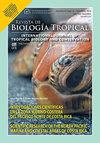在COVID-19封锁之前、期间和之后,哥斯达黎加Caño岛屿生物保护区的南半球座头鲸(新冠巨翅目)(蹄目:balaenopterae)唱歌活动
IF 0.6
4区 生物学
Q4 BIOLOGY
引用次数: 0
摘要
导语:船只交通被认为是水下噪音的主要来源。据预测,越来越多的船只出现在沿海栖息地将对海洋哺乳动物的交流产生重要影响。在哥斯达黎加,Caño岛屿生物保护区的水域是繁殖区G (BSG)座头鲸的重要繁殖区。鲸鱼的大量出现推动了观鲸活动的发展,使其成为当地经济的重要组成部分,尽管该国对这一活动有行为规范,但鲸鱼经常同时与多艘船互动。与COVID-19大流行相关的封锁提供了一个独特的机会,可以研究与船只交通相关的噪音对座头鲸歌唱活动的潜在影响。目的:确定Caño岛屿生物保护区周围的噪音水平和船舶声存在是否在COVID-19封锁期间发生变化,如果发生变化,对BSG座头鲸的歌声检测有何影响。 方法:分别于2019年9月、2020年9月和2021年9月,使用海底自动水下记录仪进行30天的声学记录,总记录时间为480小时。结果:我们的研究结果表明,与锁定期间和锁定后相比,锁定前的宽带水下噪声水平(dBRMS)明显更高,特别是在频率低于1kHz时。这可能是由于封锁期间船舶声存在比例下降所致。虽然检测到的鲸鱼歌曲的比例在不同年份之间没有变化,但在封锁期间全天检测到的鲸鱼歌曲相似,相比之下,在封锁前后,鲸鱼歌曲的比例在更多船只出现的时间内下降。 结论:这项研究表明,在2019冠状病毒病封锁期间,水下噪音水平发生了明显变化,这可能是由于船只减少所致。该研究还强调了与船只交通有关的噪音对座头鲸歌唱活动的潜在影响。本研究结果可为管理Caño岛屿生物保护区的Osa保护区(ACOSA)提供参考,以制定和实施缓解措施,以管制与游船有关的水下人为噪音。本文章由计算机程序翻译,如有差异,请以英文原文为准。
Southern Hemisphere humpback whales (Megaptera novaeangliae) (Artiodactyla: Balaenopteridae) singing activity at Caño Island Biological Reserve, Costa Rica before, during, and after COVID-19 lockdowns
Introduction: Boat traffic is recognized as a major contributor of underwater noise. Increasing presence of boats in coastal habitats is predicted to have important repercussions on the communication of marine mammals. In Costa Rica, the waters of the Caño Island Biological Reserve are an important breeding area for humpback whales from the Breeding-Stock G (BSG). Their predicted and abundant presence has fueled the development of whale watching activities as an important component of the local economy, and while the country has norms of conduct for this activity, whales often interact with multiple boats at the same time. The lockdowns associated with the COVID-19 pandemic provided a unique opportunity to study the potential impacts of noise associated with boat traffic on the singing activity of humpback whales.
Objective: Determine whether noise levels and boat acoustic presence around Caño Island Biological Reserve changed during the COVID-19 lockdowns, and if it did, what is the impact on song detection of BSG humpback whales.
Methods: Acoustic recordings were made using a bottom-mounted autonomous underwater recorder for 30 days in September 2019, 2020, and 2021, resulting in a total recording effort of 480 hours.
Results: Our results show that broadband underwater noise levels (dBRMS) during pre-lockdown were significantly higher, particularly at frequencies below 1kHz, than during and post-lockdown. This is likely due to a decrease in the proportion of boat acoustic presence during the lockdown. Although the proportion of whale songs detected did not vary among years, whale songs were detected similarly throughout the day during the lockdown, compared to pre-and-post lockdown where the proportion of whale song presence decreased during hours when more boats were present.
Conclusions: This study shows a clear change in underwater noise levels during the COVID-19 lockdown, likely due to a decrease in boat presence. The study also highlights the potential impact of noise associated with boat traffic on humpback whale singing activity. The results of this study can inform the Conservation Areas of Osa (ACOSA) in charge of managing Caño Island Biological Reserve, to develop and implement mitigation measures to regulate underwater anthropogenic noise associated with tour boats.
求助全文
通过发布文献求助,成功后即可免费获取论文全文。
去求助
来源期刊

Revista De Biologia Tropical
生物-生物学
CiteScore
1.80
自引率
0.00%
发文量
23
审稿时长
4-8 weeks
期刊介绍:
The Revista de Biología Tropical / International Journal of Tropical Biology and Conservation is a mainstream scientific journal published since 1953 and covered by Web of Science; Science Citation Index; Current Contents; Google Scholar; Scopus, SciELO and nearly 50 additional indices.
A double blind system guarantees you a fair evaluation, and our world class editorial and scientific boards provides a first decision in three working days. The journal is Full Open Access and is widely read where your article can have the highest real impact.
Since its beginning in 1953, the Revista follows these principles: objective and independent evaluation of all manuscripts; transparency in all processes; ethical use of procedures, data, specimens and subjects; fair treatment of all parties; and absolute predominance of scientific rigor over any other aspect.
 求助内容:
求助内容: 应助结果提醒方式:
应助结果提醒方式:


